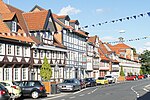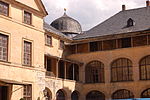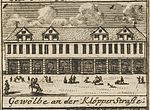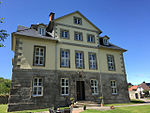Hermann Korb
Hermann Korb (* 1656 in Niese ; † 23. December 1735 in Wolfenbüttel ) was a German architect of the Baroque , which especially in the Principality of Brunswick-Wolfenbüttel and the city of Braunschweig , but also in Blankenburg and in the Duchy of Magdeburg worked.
life and work
The sources on the life of the young Hermann Korb are poor; It is therefore controversial whether he actually first learned the carpentry trade and later came to the art of building as an autodidact . As his epitaph shows , he served six dukes of Braunschweig-Wolfenbüttel, including Rudolf August , Anton Ulrich and August Wilhelm . During his lifetime, but even more after his death in 1735, he was considered one of the most important builders of his time.
His grave with epitaph is in the Johanniskirche in Wolfenbüttel. He left behind his second wife, Maria Sophie nee Schulze († 1765), who lived in the "Hofbeamtenhaus" that her husband had built, as well as a son, from his first marriage to Helene Maria Schulze († 1722), whose only godfather was 1692 Duke Anton Ulrich was.
Construction activity
From 1689, Korb was initially the princely “builder” in Wolfenbüttel, then, around 1692, “building manager”. He first worked under or later together with the equally important architect Johann Balthasar Lauterbach , whose successor he became in 1704 as "master builder". He thus held the highest position in the ducal building administration and was involved in all major building projects in Wolfenbüttel, Braunschweig and the wider area, either by planning, executing, supervising or appraising them.
His construction activity was brisk, so that a large number of buildings were built in his 40-year creative phase. Many of his works are no longer available today, as they were almost exclusively created in half-timbered construction (to imitate stone buildings) and fell into disrepair over time. Korb's work encompassed both residential buildings and public buildings, churches and residences and pleasure palaces , of which the Salzdahlum Palace , built between 1688 and 1697, and the new residential palace in Braunschweig (from 1718) are his most famous works. Other well-known works include the library rotunda in Wolfenbüttel, built from 1706 to 1710 (in which Lessing had worked since 1770 ) and the conversion (1715–1717) of Wolfenbüttel Castle into a baroque residence.
For a period of 40 years, until his death in 1735, just one year after his retirement, Korb shaped the construction industry in the Duchy of Braunschweig-Wolfenbüttel. Korb was therefore an institution during his lifetime and highly respected in his guild; he is among the most important architects of the baroque era in Germany.
Overview
![]() Map with all coordinates: OSM | WikiMap
Map with all coordinates: OSM | WikiMap
| Building | construction time | Location (location) |
comment | Illustration |
|---|---|---|---|---|
| Salzdahlum Castle | 1688-1697 |
Salt dahlum ( ⊙ ) |
New building with pleasure garden. The extensive palace complex had several inner courtyards, a cavalier's house, riding hall, opera house, an orangery and a chapel. Demolished in 1813. |

|
| Langeleben country castle | 1689 |
Long life ( ⊙ ) |
New building with pleasure garden. Demolished after 1830. The construction is attributed to Hermann Korb. |

|
| Opera house on Hagenmarkt | 1690 |
Braunschweig ( ⊙ ) |
Conversion of the Hagenrathaus into an opera house. Demolished in 1864. |

|
| Wolfenbüttel Castle | 1690-1720 |
Wolfenbüttel ( ⊙ ) |
Modification. Under Hermann Korb, the castle received a new half-timbered facade. |

|
| Brüggen Castle | 1693 |
Brüggen on the Leine ( ⊙ ) |
New building based on a design by Johann Balthasar Lauterbach. |

|
| Vechelde country castle | 1695 |
Vechelde ( ⊙ ) |
New building with pleasure garden. Demolished in 1880. The construction is attributed to Hermann Korb. |

|
| Immanuelkirche Hehlen | 1697-1699 |
Cave ( ⊙ ) |
New building. Slightly elongated octagon where the extensions on the narrow sides each form a tower. | |
| Wolfenbüttel orphanage | 1698-1704 | Wolfenbüttel ( ⊙ ) |
New building. The construction is attributed to Hermann Korb. (The photo shows the former orphanage Wolfenbüttel in the background, on the right edge of the picture) |

|
| Hohenprießnitz Castle | 1699 |
Hohenprießnitz ( ⊙ ) |
Three-wing baroque complex based on the French model. The attribution to Hermann Korb is uncertain, according to another opinion the castle was built by Wolf Caspar von Klengel as early as 1677-78 . |

|
| "Anna Vorwerk House" | 1700 | Wolfenbüttel | Herrmann Korb's house; Early 20th century Plaster facade applied to the framework and rebuilt; Home of Anna Vorwerk | |
| Arcade houses in the "Krambuden" (No. 13, 14, 15) Wolfenbüttel | 1700-1710 | Wolfenbüttel ( ⊙ ) |
Street in Wolfenbüttel. The design probably comes from Hermann Korb. | |
| Sambleben Castle | 1701 | Samble life | New building on a medieval moated castle. Two-storey four-wing building made of Elm limestone. |

|
| Achim mansion | 1701 |
Achim ( ⊙ ) |
||
| Watzum manor | 1704 |
Watzum ( ⊙ ) |

|
|
| Blankenburg Castle | 1705-1730 |
Blankenburg (Harz) ( ⊙ ) |
Conversion of the renaissance castle into a baroque residence. |

|
| Library rotunda | 1706-1712 | Wolfenbüttel ( ⊙ ) |
New construction of the library building of the later Herzog August Library in the form of a rotunda . Demolished in 1887. |

|
| Bartholomäuskapelle Braunschweig | 1708 | Braunschweig ( ⊙ ) |
Conversion of the chapel for the Reformed community on behalf of Duke Anton Ulrich . |

|
| House of the Seven Towers | 1708 | Braunschweig ( ⊙ ) |
Reconstruction and design of the baroque facade. The construction is attributed to Hermann Korb. |

|
| Bevern Palace | 1709 | Braunschweig ( ⊙ ) |
Conversion of the “Dompropstei” into a baroque residence. Demolished in 1879. The construction is attributed to Hermann Korb. |

|
| Exhibition vault | 1709-1714 | Braunschweig ( ⊙ ) |
New building. Exhibition building with the “Jungfernstieg” arcade in Klöpperstrasse, today Neue Strasse 20. The design is attributed to Hermann Korb. Completely destroyed in 1944 and replaced by a new building by Friedrich Wilhelm Kraemer between 1951 and 1953 . |

|
| Nicolaikirche Braunschweig | 1710 | Braunschweig ( ⊙ ) |
New building. One of the most important baroque buildings in Braunschweig. On October 15, 1944 completely destroyed and never rebuilt. |

|
| Sickte mansion | around 1710 |
Sickte ( ⊙ ) |

|
|
| Hundisburg Castle | 1712 (year of completion) |
Hundisburg ( ⊙ ) |
New construction of the palace and garden based on the model of the Brunswick summer residence of Salzdahlum Palace. |

|
| Eichenbarleben Castle | 1712 |
Oak bar life ( ⊙ ) |
New construction of a baroque style castle that was destroyed in the Thirty Years War . The construction is attributed to Hermann Korb. |

|
| Salder Castle | 1695-1713 |
Salder ( ⊙ ) |
After the acquisition by the later Duke August Wilhelm in 1695, the palace was rebuilt and expanded according to Korb's plans. |

|
| Luther Church | 1715-1717 | Blankenburg | Church of the Georgenhof, rebuilt by Korb's pupil Joachim Eimbrod 1735–1737 |

|
| Residential palace in Braunschweig | 1718-1790 | Braunschweig ( ⊙ ) |
New construction of the residence of the Dukes of Braunschweig-Wolfenbüttel. Burned down on September 7, 1830 . |

|
| Dehnsches Hofbeamtenhaus | 1718-1720 | Wolfenbüttel ( ⊙ ) |
Conversion of an older half-timbered house into a representative city residence in baroque style. For the eponymous person see Konrad Detlev von Dehn . |

|
|
Trinitatiskirche Wolfenbüttel I and II |
I: 1700 (year of consecration) II: 1716–1719 (year of consecration) |
Wolfenbüttel ( ⊙ ) |
New building. The building (Trinity I), inaugurated in 1700, was destroyed by fire five years later. |

|
| Prinzenpalais in Wolfenbüttel (Reichsstrasse 1) | 1722 ff. | Wolfenbüttel | Princely extension with ballroom to the Hofbeamtenhaus Reichsstrasse, built in 1603. 1. In 1730–33 inhabited by Carl (later Carl 1.) and his wife Philippine-Charlotte | |
| Holy Trinity Church (Heimburg) | 1724-1726 |
Heimburg ( ⊙ ) |
New building. Probably designed by Hermann Korb. |

|
| Dehnsches Palais | 1725 | Braunschweig ( ⊙ ) |
City palace with extensive gardens based on the French model. Canceled in 1857. For the eponymous person see Konrad Detlev von Dehn . |

|
| Waldhof Hasselfelde | 1725-1726 | Hasselfelde | Not preserved country palace in the Harz district |

|
| Walkenried hunting lodge | 1725-1730 |
Walkenried ( ⊙ ) |
New building. Country palace built on behalf of Duke August Wilhelm . | |
| Small Wolfenbüttel Castle | 1730 | Wolfenbüttel ( ⊙ ) |
Conversion and extension to a two-storey half-timbered building with mezzanine . |

|
| Antoinettenruh Castle | 1733 | Wolfenbüttel ( ⊙ ) |
Country castle not preserved. The construction is attributed to Hermann Korb. |

|
Korb's 350th birthday in 2006
Under the title "Hermann Korb (1656−1735) - Baroque Building in the Principality of Braunschweig-Wolfenbüttel" (see web links), the Museum in Wolfenbüttel Castle and the Department of Building History at the Technical University of Braunschweig initiated a research and exhibition project that included the The aim was to further research and re-evaluate Korb's work and influence on his contemporaries and posterity, and to bring the master builder Korb and his work into the awareness of a broad public. For this purpose an exhibition took place in Wolfenbüttel in November 2006. The project was supported by the Lower Saxony Foundation and the Nord / LB • Public Foundation.
literature
- Udo von Alvensleben : The Brunswick castles of the baroque and their master builder basket. German Art Publishing House, Berlin 1937.
- Elmar Arnhold: Korb, Hermann. In: Horst-Rüdiger Jarck , Dieter Lent et al. (Ed.): Braunschweigisches Biographisches Lexikon - 8th to 18th century . Appelhans Verlag, Braunschweig 2006, ISBN 3-937664-46-7 , p. 413 f .
- Harald Blanke: Still difficulties with Hermann Korb. A sketch for Udo von Alvensleben's monograph against the background of recent research. In: Harald Blanke (Ed.): A brotherly alliance œuvre. Contributions to garden art, history and preservation of monuments in the work of Udo von Alvensleben and Anco Wigboldus. KULTUR-Landschaft Haldensleben-Hundisburg eV , Hundisburg 2004, pp. 79–90.
- Willy Gerking: Baroque master builder Hermann Korb born in Niese. In: Willy Gerking: The history of the village of Niese. Pegnitz 2011, pp. 65-68.
- Wolfgang Kelsch: Hermann Korb. Baroque master builder at the Fürstenhof in Wolfenbüttel. History Association, Braunschweig 1985.
- Museum in Wolfenbüttel Castle, Department of Building History of the TU Braunschweig (Ed.): Hermann Korb and his time. Baroque building in the Principality of Braunschweig-Wolfenbüttel. Appelhans Verlag, Braunschweig 2006, ISBN 978-393766451-4 .
- Simon Paulus: Hermann Korb (1656-1735) - The master builder Duke Anton Ulrichs of Braunschweig-Lüneburg . In: Werner Oechslin (ed.): Architect and / versus master builder - the question of the profession , files of the seventh Int. Baroque summer course of the Werner Oechslin Library Foundation 2006, gta-Verlag, Zurich 2009, pp. 152–161, ISBN 978-385676259-9 .
- Hans Reuther : Korb, Hermann. In: New German Biography (NDB). Volume 12, Duncker & Humblot, Berlin 1980, ISBN 3-428-00193-1 , p. 580 f. ( Digitized version ).
- Paul Zimmermann : Korb, Hermann . In: Allgemeine Deutsche Biographie (ADB). Volume 16, Duncker & Humblot, Leipzig 1882, p. 701.
Web links
- Hermann Korb (1656-1735) - Baroque building in the Principality of Braunschweig-Wolfenbüttel - project on the occasion of the 350th birthday in 2006 on hermannkorb.de
- Literature by and about Hermann Korb in the catalog of the German National Library
- Computer model of the Wolfenbüttel library rotunda
Individual evidence
- ↑ Historical photographs of the Messegewölbe on Bildindex.de , accessed on February 23, 2014
- ↑ Historical photographs of the Nicolaikirche Braunschweig on Bildindex.de , accessed on February 23, 2014
- ↑ https://www.evangelisch-in-blankenburg.de/kirchen/lutherkirche.html History of the Lutherkirche Blankenburg
| personal data | |
|---|---|
| SURNAME | Korb, Hermann |
| BRIEF DESCRIPTION | German builder of the baroque |
| DATE OF BIRTH | 1656 |
| PLACE OF BIRTH | Niese (Lügde) , Principality of Lippe |
| DATE OF DEATH | December 23, 1735 |
| Place of death | Wolfenbüttel |
